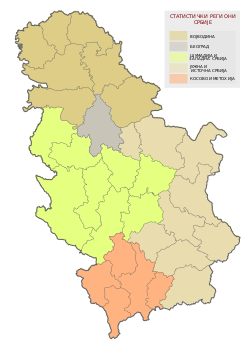Inđija
Inđija (Serbian Cyrillic: Инђија, pronounced [ǐndʑija]) is a town and a municipality located in the Srem District of the autonomous province of Vojvodina, Serbia. As of 2011, the town has total population of 26,025, while the municipality has 47,433 inhabitants. It is located in the geographical region of Syrmia.
Inđija | |
|---|---|
Town and municipality | |
 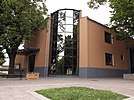 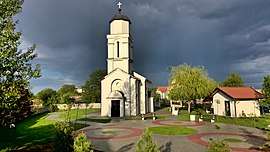 From top: Municipality building, Cultural Center in Inđija, Outlet Park Inđija, Serbian Orthodox church in Ljukovo | |
 Coat of arms | |
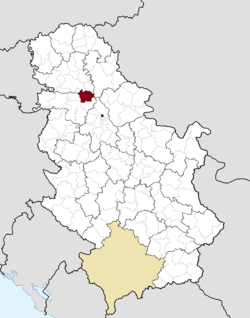 Location of the municipality of Inđija within Serbia | |
| Coordinates: 45°03′N 20°05′E | |
| Country | |
| Province | Vojvodina |
| District | Srem |
| Settlements | 11 |
| Government | |
| • Mayor | Vladimir Gak (SNS) |
| Area | |
| • Town | 47.96 km2 (18.52 sq mi) |
| • Municipality | 384.61 km2 (148.50 sq mi) |
| Elevation | 116 m (381 ft) |
| Population (2011 census)[2] | |
| • Town | 35,358 |
| • Town density | 740/km2 (1,900/sq mi) |
| • Municipality | 47,433 |
| • Municipality density | 120/km2 (320/sq mi) |
| Time zone | UTC+1 (CET) |
| • Summer (DST) | UTC+2 (CEST) |
| Postal code | 22320 |
| Area code | +381(0)22 |
| Car plates | IN |
| Website | www |
Name
According to the legend, the name of the town comes from Turkish word "ikindia" – meaning evening prayer and is related to the time after 1699 when the town fell under Turkish rule. On the other hand, there is the claim that the town was named after the name of Orthodox women – Inđija. Newest researches states that name of the city is taken from Latin word "Indigena" meaning "indigenous". This theory is most relevant, due to presence of ancient Illyrian, Celtic and Roman settlements in neighbourhood of modern Inđija. In Serbian, the town is known as Inđija (Инђија), in Croatian as Inđija, in Hungarian as Ingyia, in German as India, in Slovak as India or Indjija, and in Rusyn as Индїя.
History

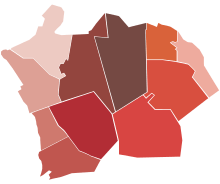
The first verifiable evidence of Inđija's existence is in the Charter of Despot Jovan Branković from 1496, but it may have existed as early as 1455 as possession of Hungarian noble family Sulyok. During the Ottoman administration (16th-18th centuries), Inđija was mostly populated by ethnic Serbs, and was part of the Ottoman Sanjak of Syrmia.
Since 1717, Inđija was part of the Habsburg Monarchy, and became a feudal domain of Count Marko Pejačević of the Pejačević family that originated from Chiprovtsi, Bulgaria. The old medieval Inđija was placed a little bit to the north than today town. The present-day Inđija was founded by the Serb settlers from Beška and Patka in 1746. According to the description from 1746 it had 60 households, while in 1791 it has already grown to 122 households with 1,054 residents. In the second half of the 18th century, this new settlement was mostly populated by ethnic Serbs. Germans and Czechs start settling in Inđija at the beginning of the 19th century, while Hungarians migrated there towards the end of the century. During the time, Germans became dominant population in the town.
In the middle of the 18th century, Inđija became part of the Syrmia County of the Kingdom of Slavonia, which also was part of the Habsburg Kingdom of Croatia and of the Habsburg Kingdom of Hungary. In 1848-1849, it was part of autonomous Serbian Vojvodina, while from 1849 to 1860 it was part of the Voivodeship of Serbia and Banat of Temeschwar. Since 1860 Inđija was again part of the Kingdom of Slavonia, which in this time was a completely separate Habsburg crownland. Kingdom of Slavonia was subsequently (in 1868) joined with the Kingdom of Croatia into newly formed Kingdom of Croatia-Slavonia, which, following the 1868 Croatian–Hungarian Settlement, became an autonomous kingdom within the Habsburg Kingdom of Hungary and Austria-Hungary.
First fairs started to take place in Inđija at the beginning of the 19th century, when the state's postal service was established. Telegraph became operational in Inđija in 1850, while postal money transfers commenced in 1886. The first bank was established in 1897, and the first trade school in 1897. The first electric plant in Inđija started with its operations in 1911.
The industrial progress in Inđija was initiated with the establishment of mills in the mid 19th century, and the first larger steam operating mill, with a capacity of 10 cars of wheat per day, was built by a company from Budapest in 1890. After the mills, the brick factories followed, while the carpentry tradition and furniture production started in 1876. At the beginning of the 20th century, a famous fur factory was established, while the spirits factory was built in 1912.
Industrial development of Inđija is largely related to the development of railroad infrastructure. The railroad reached Inđija in 1883, from two directions: from Subotica and Zagreb in the north and west respectively, continuing towards Belgrade. This has practically positioned Inđija on the crossroads of two key Balkan railroad directions.
Since 1918, Inđija was part of the Kingdom of Serbs, Croats and Slovenes (renamed to Kingdom of Yugoslavia in 1929). After the World War I, first factories were established producing anything from strollers for children, nails, jam, powdered eggs, and parachutes, to textiles and metal processing industry right after the World War II. In the first half of the 20th century Inđija became a traditional trading destination and headquarters of successful trade companies. The first modern road in Serbia the so-called "International Road" (Novi Sad–Beograd) passed through Inđija in 1939.
Prior to World War II, 5,900 of the total population of 7,900 was composed of ethnic Germans. The town was at the time one of the most developed settlements in Vojvodina, and a spiritual and cultural center of Germans in the Syrmia region.
During the World War II (1941–1944), the town belonged to the Independent State of Croatia. After the defeat of Axis Powers, in 1944, the German army was expelled and most of the Yugoslav Germans were forcibly removed from the country. Those who remained in Yugoslavia were sent to prison camps. After camps were abolished (in 1948), most of the remaining Yugoslav Germans were expulsed to Germany. After 1944, new migratory patterns intensified and, according to 1953 census, Inđija was mainly populated by Serbs. Population of the town increased from 7,758 in 1948 to 26,247 in 2002.
As of the 2002 census, 87.61% of the town population are Serbs, while it also maintained its old cosmopolitan spirit of inter-ethnic tolerance. Inđija is also one of the economically most advanced Serbian municipalities, and a premium investment destination.
Inhabited places
Inđija municipality includes the town of Inđija and the following villages:
Demographics
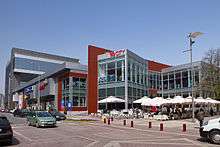
| Year | Pop. | ±% p.a. |
|---|---|---|
| 1948 | 27,600 | — |
| 1953 | 29,287 | +1.19% |
| 1961 | 36,484 | +2.78% |
| 1971 | 40,530 | +1.06% |
| 1981 | 44,151 | +0.86% |
| 1991 | 44,185 | +0.01% |
| 2002 | 49,609 | +1.06% |
| 2011 | 47,433 | −0.50% |
| Source: [3] | ||
According to the 2011 census results, the municipality of Inđija has 47,433 inhabitants.
Ethnic groups
Most of the settlements in the municipality have an ethnic Serb majority. The settlement with Slovak ethnic majority is Slankamenački Vinogradi.
The ethnic composition of the municipality:[4]
| Ethnic group | Population |
|---|---|
| Serbs | 40,871 |
| Croats | 1,569 |
| Hungarians | 829 |
| Romani | 426 |
| Ukrainians | 391 |
| Slovaks | 380 |
| Yugoslavs | 210 |
| Montenegrins | 117 |
| Macedonians | 71 |
| Slovenians | 46 |
| Russians | 39 |
| Germans | 34 |
| Muslims | 19 |
| Others | 2,431 |
| Total | 47,433 |
Economy
Railways in Inđija | ||||||||||||||||||||||||||||||||||||||||||||||||||||||||||||||||||||||||||||||||||||||||||||||||||
|---|---|---|---|---|---|---|---|---|---|---|---|---|---|---|---|---|---|---|---|---|---|---|---|---|---|---|---|---|---|---|---|---|---|---|---|---|---|---|---|---|---|---|---|---|---|---|---|---|---|---|---|---|---|---|---|---|---|---|---|---|---|---|---|---|---|---|---|---|---|---|---|---|---|---|---|---|---|---|---|---|---|---|---|---|---|---|---|---|---|---|---|---|---|---|---|---|---|---|
| ||||||||||||||||||||||||||||||||||||||||||||||||||||||||||||||||||||||||||||||||||||||||||||||||||
The following table gives a preview of total number of registered people employed in legal entities per their core activity (as of 2018):[5]
| Activity | Total |
|---|---|
| Agriculture, forestry and fishing | 297 |
| Mining and quarrying | - |
| Manufacturing | 5,609 |
| Electricity, gas, steam and air conditioning supply | 74 |
| Water supply; sewerage, waste management and remediation activities | 283 |
| Construction | 380 |
| Wholesale and retail trade, repair of motor vehicles and motorcycles | 2,289 |
| Transportation and storage | 601 |
| Accommodation and food services | 358 |
| Information and communication | 116 |
| Financial and insurance activities | 143 |
| Real estate activities | 15 |
| Professional, scientific and technical activities | 328 |
| Administrative and support service activities | 263 |
| Public administration and defense; compulsory social security | 375 |
| Education | 612 |
| Human health and social work activities | 792 |
| Arts, entertainment and recreation | 102 |
| Other service activities | 198 |
| Individual agricultural workers | 371 |
| Total | 13,207 |
Society and culture
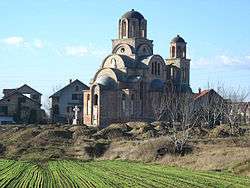

Culture
Numerous cultural historical monuments, modern and prehistoric, are testify to the turbulent history of this region. Remains of Roman and medieval fortress and a monument to the Battle of Slankamen talk about the strategic importance of this area of the Danube, which was the border of various empires through history.
Urban core Indjija dates from the late nineteenth and early twentieth century, from the period of industrial development and the period of German nationality residents settling when building of Municipal Administration, house of Vojnovics,[6] the Roman Catholic Church of St. Peter, the building of the presbytery and townhouses with frontage eclectically designed with elements Baroque, Classical, Renaissance and Art Nouveau were built. Somewhat earlier Church "Vavedenja presvete Bogorodice" was formed, which by its proportions, is one of the most beautiful and most suitable buildings in Srem preserved from the eighteenth century.
With its new pedestrian zone with a monumental square, modern building of the Cultural Center[7] floral arrangements and street furniture, Indjija builds an image of the European city tailored for a modern man.
On June 26, 2007 there was a concert of The Red Hot Chili Peppers held in Inđija. The concert lasted for about 1 hour and 20 minutes and was a part of Green Fest. Around 90,000 to 100,000 people, many of them from neighbouring countries, came to see one of today's most popular bands.
Sport
Inđija has a football club FK Inđija competed in the Serbian First League and an American football club Inđija Indians competing in the SAAF league. Woman handball club ŽRK Železničar Inđija finished sixth in Handball Super League of Serbia for Woman.[8] Basketball club named Železničar is currently playing in third division, but has participated in Basketball League of Serbia in 2011-12 season.
Indjija was elected as one of the hosts of the 2009 Summer Universiade, which was held in Serbia in July 2009.
Education
Indjija has 10 elementary school, 3 middle schools[9] and Faculty of Technical Sciences(Novi Sad) Department for Software Engineering[10]
- Elementary schools
- Dušan Jerković
- Petar Kočić
- Jovan Popović
- Braća Grulović - Beška
- Branko Radičević - Maradik
- Dr Đorđe Natošević - Novi Slankamen
- Ruža Đurđević Crna, Čortanovci
- Slobodan Bajić Paja, Novi Karlovci
- 22. jul, Krčedin
- Petar Kočić - Ljukovo
- Middle Schools
- Technical School Mihajlo Pupin
- Đorđe Natošević School
- Gymnasium (Gimnazija) Indjija
Religion
Inđija has two main churches: Serbian Orthodox Church (from 1756) and Roman Catholic Church (from 1867-1872). There is also a new Orthodox church. Smaller, home-based, Protestant congregations also exist.
Gallery
- Outlet Park Inđija Entrance
 Outlet Park Inđija
Outlet Park Inđija Cultural Centre Inđija
Cultural Centre Inđija Cara Dušana street
Cara Dušana street- Aeral view of Inđija
Notable people
- Arsenije Sremac, the second Archbishop of the Serbian Orthodox Church
- Nenad Bogdanović, Mayor of Belgrade
- George Seitz, Australian politician
- Zoran Janković, Bulgarian football player
- Slobodan Popović, middle distance runner, Universiade champion
- Miroslav Raduljica, basketball player, silver medalist at the 2016 Summer Olympics and 2014 FIBA World Cup
- Bojan Banjac, football player for Lille OSC
- Milan Bubalo, football player
- Dejan Georgijević, football player
- Srđan Dimitrov, football player
- Darko Lemajić, football player
- Bojan Dubajić, football player
- Vladimir Tintor, football player
International relations
Twin towns - sister cities
Inđija is twinned with:[11]
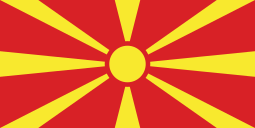




See also
- Syrmia
- Syrmia District
- List of cities, towns and villages in Vojvodina
- List of places in Serbia
References
- "Municipalities of Serbia, 2006". Statistical Office of Serbia. Retrieved 2010-11-28.
- "2011 Census of Population, Households and Dwellings in the Republic of Serbia: Comparative Overview of the Number of Population in 1948, 1953, 1961, 1971, 1981, 1991, 2002 and 2011, Data by settlements" (PDF). Statistical Office of Republic Of Serbia, Belgrade. 2014. ISBN 978-86-6161-109-4. Retrieved 2014-06-27.
- "2011 Census of Population, Households and Dwellings in the Republic of Serbia" (PDF). Stat.gov.rs. Statistical Office of the Republic of Serbia. Retrieved 19 August 2017.
- "ETHNICITY Data by municipalities and cities" (PDF). stat.gov.rs. Statistical Office of the Republic of Serbia. Retrieved 22 February 2018.
- "MUNICIPALITIES AND REGIONS OF THE REPUBLIC OF SERBIA, 2019" (PDF). stat.gov.rs. Statistical Office of the Republic of Serbia. 25 December 2019. Retrieved 28 December 2019.
- "Turistička organizacija opštine Inđija - Kuća Vojnovića". Indjija-tourism.com. Retrieved 28 August 2017.
- "Archived copy". Archived from the original on 2013-06-27. Retrieved 2013-05-28.CS1 maint: archived copy as title (link)
- "Archived copy". Archived from the original on 2013-02-01. Retrieved 2013-05-28.CS1 maint: archived copy as title (link)
- "Archived copy". Archived from the original on 2012-06-06. Retrieved 2012-08-15.CS1 maint: archived copy as title (link)
- "U Inđiji prva generacija studenata na budžetu". Blic.rs. 28 November 2015. Retrieved 28 August 2017.
- "Братски градови и општине". indjija.net (in Serbian). Inđija. Retrieved 2020-01-07.
External links
| Wikimedia Commons has media related to Inđija. |

